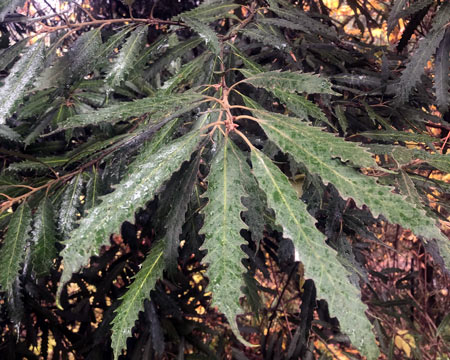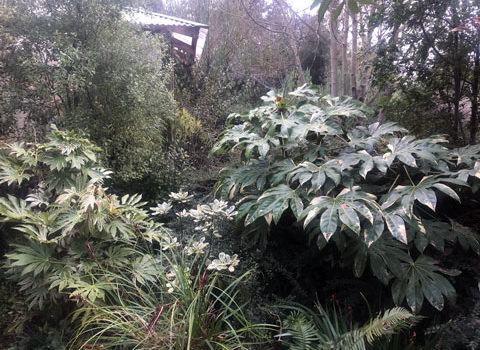
Broadleaved Evergreens with Sean Hogan
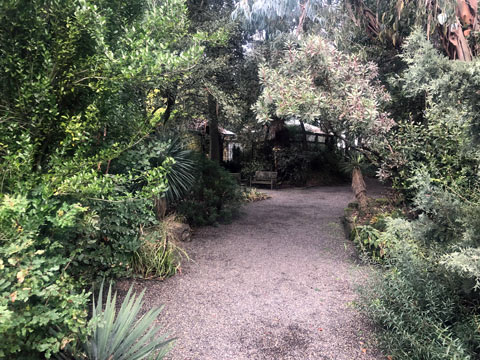
This week we sat down with Sean Hogan, one of the country’s most brilliant horticulturists, and one that lives just down the street from us on Sauvie Island. Sean runs Cistus Design Nursery that specializes in unique climate adapted plants and broadleaved evergreens that thrive in our climate. He quite literally wrote the book on broadleaved evergreens for our climate, Trees for All Seasons, and has been facilitating a horticultural revolution in Portland and all over the west coast since the early ‘90s. His plant collections and introductions to the nursery trade range far and wide but always have a common theme: drought tolerance, beauty in all seasons, and usually evergreen. From the Siskiyous to the Andes and Arctostaphylos to Zauschneria Sean has introduced more selections of unique plants than any horticulturist in recent memory.
We’ve been fans of Cistus Nursery for years and rely on Sean’s ever growing catalog for all of our landscape design projects. At a time when global biodiversity is dwindling Sean shows us just how much is still out there for those willing to get off the beaten path and look for it. Every meeting with Sean is rich, playful and full of wonder and he’ll leave you with a treasure trove of new knowledge and likely a new plant or twelve to add to your garden.
We caught up with Sean and Preston Pew this past weekend to ramble and wander through their thoughts on Portland’s urban canopy and its history, the Northwest nursery trade, understanding our summer dry climate, and plant exploring all over the world!
And if you want to experience Sean’s brilliance firsthand, make a trip down to Sauvie Island or visit cistus.com to check out their mail order catalog! You won’t be disappointed.
Sam: So, it’s midwinter here in Portland and looking around, if you didn’t know where in the world you were, you might not know that you were in the lush green mild Pacific Northwest this time of year.
Sean: That is very true. Except for what you’ve planted around here.
Sam: Well thank you, but for the majority of the city we’ve planted it out as if it were Detroit, or New York at best or some cold climate like that.
Sean: Well it’s an interesting study in history. When I first moved back to Portland I was infatuated with why there were so many eastern and northeastern plants here. And also, being a plant geek, looking at the fact that by the end of May as we say around here, “We’re having really beautiful fall color here at the end of May,” because so many plants are so stressed. And I couldn’t really understand why this was happening.
Phyllis Reynolds, who wrote the book Trees of Greater Portland, personified a little bit of it for me. She was on my board at Hoyt Arboretum and she said, “Well we’re a New England city so I just really don’t like things that don’t look New England.” And I consider her rather wise and fairly thinking but if you read her book she says many things, and for example you’ll see a picture of a grand old Windmill Palm, and her caption was ‘Trachycarpus fortunei, Portland is becoming rife with these’.
Sam: Is that the same book that claimed the Canyon Live Oak as ill suited to our climate even though there’s specimens over 100 years old around town?
Sean: I don’t remember, but she did say things like loquat is a horrible looking plant, ill suited to our climate and shouldn’t be planted here. And yet there’s a 100 year old one at that temple on Clinton St. looking stunning as far as I can tell.
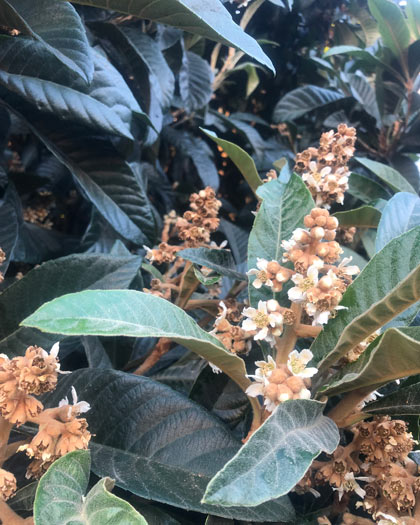
Sam: That tree’s a self fertile one that we’ve been taking cuttings from. It fruits every year!
Sean: Exactly, but looks wrong to some’s sensibilities. So my premise is that, looking back, Portland is only 150 years old roughly.
Sam: We’re a baby city.
Sean: Yes and we’re just finding out what our style is. And we’re making it ourselves. And despite what convention tells us, you and I and some of our friends are making a style for ourselves here. I think that’s pretty cool. And slowly but surely you’re seeing gardens that are growing some pretty amazing stuff, and they’re not involving Styrax that turn brown in June. They’re featuring plants that really like our climate.
But I think what is maybe more straightforward is the fact that we have this incredibly successful and large nursery industry in the Willamette Valley that grows something like 90% of the country’s woody plants. Sauvie Island (where Cistus Nursery is located) has Bailey Nursery which is huge. They lift these things at this time of the year, put them in their cooling shed so they get enough chill hours, put them back in the ground and get phenomenal growth on things. So unfortunately I think the biggest problem here is that we grow a ton of cold climate deciduous stuff for the East Coast and it’s not suited for us, but it’s cheap. And our architects often don’t have a horticultural training and they read Dirr’s book about the east coast. We have nurseries that are pumping out red maples by the millions and they’re cheap or planting ashes and pretending like the Emerald Ash Borer isn’t on its way. But just because we have these things here so cheap is one of the main reasons they’re everywhere .
And then we have our tree planting organizations who are certainly very well meaning. But I imagine each tree liaison, wanting to do something good, but not being particularly knowledgeable, and then suddenly saying “We need 57,000 trees, let’s call one of the big nurseries and see what they have left over.” It’s kind of like Arbor Day where they say we’ll plant a tree in your name. But what kind of tree and where…
Sam: Yes, no minor detail!
Sean: And then we have our arborists, and the career of being an arborist is often more about the sport of being an arborist than it is about the species. And we have a very large contingency of arborists from the Midwest who are all about roping and climbing big trees but not necessarily about a live oak versus a maple. So it’s a little bit of a self infliction that we’ve got going on.
Sam: Stuck in this institutionalized cycle.
Sean: Exactly, and that pretty much sums up my conspiracy theory (laughter).
A few years ago before I wrote the broadleaved evergreen book (Trees For All Seasons), we were deciding what kind of book we’d write. And I was riding down Front Ave working my way to Timber Press, and not only were there pin oaks, which are not only one of the least adapted oaks for our climate, but there we were in January and they were just shredded with all these dead leaves. And under that were all the Mediterranean exotic weeds coming up right by them. And then they just planted Dawn Redwoods and something else, I think Red Maples along Naito Parkway, also dark and dismal. And it’s grey and I said “Here we are, January in Portland. Let’s just make this as bad and dreary as we can.” And so at that meeting at Timber Press we talked about things that either grow in the winter or stay green.
Since then it’s been a bit of a campaign with people throughout the city who have drank the Kool-Aid so to speak, and they’re in many ways going for it.
Now on that recent project you’re involved with they had Styrax in the plan but I want to change them all out to cork oaks. So I called Urban Forestry and a guy took my call, didn’t know who I was, and I told him what I wanted to do and he said, “Well, you know here at Urban Forestry we would like to say that we are promoting the use of broadleaved evergreens,” and then went on his spiel about the benefits of broadleaved evergreens and said if you’d like me to send you any literature I’d be happy to do that.
Preston: He was offering to send you literature??
Sam: The guy who wrote the literature!
Sean: Yeah, exactly! But it was really nice to hear.
When I first moved back to Portland in ’95 or ’96, the Knott St townhomes at MLK right across from the Nike store, a public housing project so I volunteered to do a planting plan for them and one of the things I used was the canyon live oak as a street tree and I was denied the permit. And so I called the city and said, “What!?” and they said, “Those are California trees. They won’t grow here. It gets way too cold and way too wet in the summer here. They don’t like it where it rains everyday.” And so there was no teachable moment there because they were not gonna hear it. And the funny thing is it was that afternoon I was up exploring the Alameda neighborhood and found the now 100 year old Canyon Live Oak at the Autzen House that had a heritage tree placard, nailed into the bark, but there it was. But the gist there is, why look like Detroit in winter when you don’t have to?
And what we started to do is sort of what I call the compromise. So we’re doing street plans. They planted all these Norway Maples down Broadway which are one, they’re invasive and two, they’re not nearly drought tolerant. They need to be near a creek. And of course they were dying back pretty ferciously. So I suggested: If you’re afraid do one to three broadleaved evergreens per city block. Plant your deciduous stuff. And think about how that’s going to look in January when you have an alley of green rather than what he have now..
Sam: Sticks….
Sean: Yeah and so take 82nd Ave, Avenue of the Roses. Very romantic name. Can you imagine if 100 years ago, across that lovely 5 lane expanse they had planted, say… evergreen oaks. It would look like Charleston. Those limbs would be meeting across the avenue there and it would be a sight to behold. So that’s a visual. More about design than anything else but really important just by happenstance that these things are adapted. Many of them are from summer dry climates, including our own summer dry climate with canyon live oaks being native. Other things like cork oaks and holly oak are superbly adapted. And then we’re doing other things like Arizona oak or silver oak that are adapted to periodic drought. They can do a Mediterranean summer. If you can give a little extra water you’ll get monsoon growth out of them. Otherwise they’re totally fine. They compartmentalize well. Their structure is amazing.
And one thing we like to talk about with homeowners in the city is the way these things grow. So a red maple is a water searcher. They’re from swamps. They don’t live long here just because they don’t get the winter chill. But they will lift any infrastructure they please. They’re just about finding water. The inverse is, say, an Arizona oak. It finds water but knows how to do it. So those roots tend to go down and those roots have this interesting succulent capacity so if you look at those oaks in a place where they grow them their trunks tend to blob over the sidewalk, a little bit like some of us with our belts. They take advantage of the spot that they’re in, store water, but they don’t really do much to infrastructure. Also if you look at the branch bark collar, they just heal over so well. So there’s a lot of interesting structural things about them too that makes us love them.
But…winter leaves, winter flowering… and then you have a whole set of things that don’t necessarily come from summer dry climates but they have the coolness factor so they’re worth a little broader planting. Loquats for instance, they do need some summer water to establish here, not a whole bunch, but talk about winter flowering, fragrance, fruit, gorgeous leaves. You can wear them…
Sam: Make a skirt!
Sean: Yeah! At least a headband… and Azaras, smelling like vanilla, flower in the winter… Eucalyptus… and again our native things: Ceanothus, Arctostaphylos, Notholithocarpus.
Sam: Which just those last three genera get into the whole issue of people’s perspective on what is native, and the snapshot ecology we have of what we consider native.
Sean: Well it’s funny, maybe you don’t have this as much as we do but we have a pretty wide cross section of people that come into the nursery and there was a story several years ago, two groups came in separately and the first group said, “These are those people with all those natives”, and rolled their eyes, and another group said “Ugh, they grow exotics!” As if that was just really bad. So you can’t please everybody.
So it’s been an interesting process for some people to look at Arbutus, Ceanothus, Arctostaphylos, many Vaccinium, Garrya, Baccharis… all of these things are evergreen and ours.
Plant Exploring
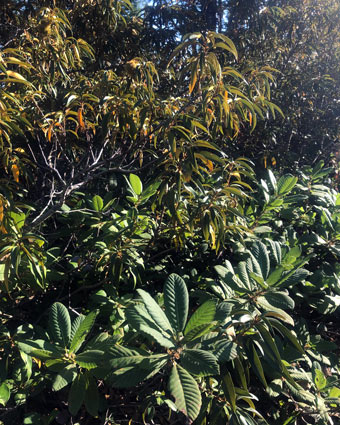
Sam: Now let’s dive a little bit into where some of these things are coming from, broadleaved evergreens and all the fun funky stuff that Cistus carries. Because you all do more plant exploration and collecting than probably anybody in the nursery trade. And selections and introductions from all over but especially up and down the West Coast and some of those hot spots you have, areas like the Siskiyous, what makes those areas so special and unique and diverse?
Sean: It’s probably a little bit of a parallel to what you guys do, in looking at those cultures and places that have produced these things that might not have been really discovered by the rest of the world and we’re the ones that bring them here. And I’ve always had a connection to the communities we have in Portland, and always looking for the next cool thing that we all want to plant. So we look for stuff all over the world because we want that richness and diversity.
Sam: And why wouldn’t you?
Sean: Exactly, so we tend to concentrate on either parallel or adapted climates. We concentrate on other Meditteranean climates or our own. So places that are dry in the summer and get their water in the winter. That’s maybe 10 or 15 percent of the inhabited world, but that’s our climate so let’s search there. But because of that not very many people are doing it. Secondarily, we’re looking at a lot of places that do get periodic drought because a lot of plants that have adapted to being Meditterranean are derived from those that get periodic drought. So our little strip of dry summer from 46 inches in Victoria to all of western Baja, these plants panned out from somewhere. So if you look east there’s this web of flora and its kin that go from the Sierra through the Southwest to eastern Mexico to Guatemala and back. And we can find an irregular amount of stuff that might not be solidly summer drought adapted but it’s really tough. And it seems to certainly love it here.
Preston: And can take periodic, infrequent watering…
Sean: And still look amazing.
Sam: And give it a bit of water (but not too much) and it looks really amazing. And you just named so many of the spots that we see you collecting plants from.
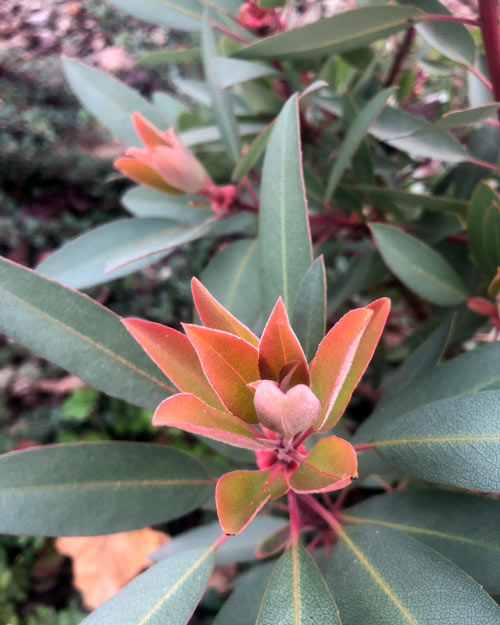
Sean: And there’s the equivalent in Chile and Argentina as well as the true Meditteranean and Greek Isles. There’s just so much stuff for us there. Unfortunately Australia doesn’t go very far south (away from the equator) so western Australia’s flora often doesn’t grow here. But southeastern Australia has some Mediterranean qualities and high elevations where so many of our hardy bottlebrushes, melaleucas, eucalyptus, grevilleas, so many things that we like to grow come from.
Preston: Callistemon, Leptospermum…
Sean: And some of them are riparian but a lot of them also have a lot of drought tolerance. And so I’d say we focus on parallel climates but we also focus on what I call transition zones. So maybe if we’re in a subtropical zone we look at high elevations, maybe on the frontier closest to the pole. There’s so many places in Mexico, China, Vietnam, Brazil, Chile and other places where you have influence from a huge diversity of plants and of course eventually they hit against harsher climates. But then we can find the highest elevation at which something grows, something’s in a frost pocket but they’re also historically surrounded by all this diversity around them and then there’s so much more to choose from and they’re all trying to make it. They’re all trying to win the race.
And I think a good example for us would be Central and South Central Chile. People seem to want to gravitate toward the far south, Punta Arenas, Patagonia, but diversity there is relatively pretty low. There’s good stuff there but it’s chilly and it’s very wet. It’s pretty mild because it’s got an awesome on shore flow.
Sam: It almost has a more mild Alaska or B.C. feeling.
Sean: Yeah, exactly. It’s kind of like Queen Charlotte Islands. And so there’s some interesting stuff there but doesn’t tend to like our heat and there isn’t a lot of it, and it’s been glaciated to crud so it’s like yeah whatever grew back on the rocks. So where we tend to look is what’s in Central Chile where you’ve got the whole crux of it all. You’ve got a huge number of the South American Nothofagus, Podocarps, guavas, all those cool things that are edible and/or with enough sugar and strawberry syrup taste amazing. But there they all are.
So as you’re going up in elevation, and it’s a little bit inland, so you’re getting better diurnal temperature change. You’re getting more heat, which we need, but you’re also getting cold nights in the winter and they have a lot of frost pockets so some of the areas in Central Chile get a good deal colder than say Bolivia and yet you have six Nothofagus species instead of one. So that to me is pretty interesting. A lot of the places Mike Remmick and I have gone collecting are right at this interesting convergence right at the edge of a plant’s tolerance and I’m going to choose that one.
Sam: And that’s something you all have done such a good job of, finding things that everybody says, “That’s not hardy here. That species could never make it.” And then you find one individual in some cold pocket or high elevation, or maybe it’s a hybrid offspring with more cold hardiness than the tender one of its parents.
Sean: An interesting way to think of it is, how do plants come into cultivation? And it’s not magic. We have plenty of things that are color spot, done in a laboratory, so you can get Tootie Fruity Echinacea now, which is fine, but that’s not really what we’re all about. But if you think of for instance, Eucalyptus fill-in-the-blank-acus…a long time ago I looked at all these things and thought, where did all these people go (to collect them)? So I actually looked at distribution maps, and I did it for Australia and I superimposed a road map. Interesting… almost every recorded species in Australia grows adjacent to roads. Probably with a pull out and maybe a rest stop. And so that really made me realize that most things we have in cultivation that are not multi, multi, multi bred species, they reflected that stop on the way to the beach. “Oh that’s pretty, get some seed.” So it really made me realize how a lot of these things came to be…
And the freeze in 1990 in Berkeley, we got to 12 degrees. It was below freezing for about 10 days, day and night. I mean talk about frozen slush, it got hit worse there that year than it did here. And so I’m seeing it coming and ripping all these things out of the ground and throwing them in greenhouses and watching sprinklers explode and spew water all over this stuff. And I’m there by myself in my waterproof rain suit shlopping pitchforks of rotten cacti into wheelbarrows and thinking, “What kind of a career choice did I just make?”
But it really made me start thinking of the fact that all of this country has high country. It has areas closer to the poles. And that’s where a lot of these things come from. Cold hardy ice plants and proteas and things like that. South Africa has places where ground frost heaves during the winter, so let’s go there! They have interesting things too. So a lot of it is just common sense, or at least makes sense for us.
Sam: Yes, definitely, but if you’re not looking at the world through that lense, like the project we did down the road from you on Sauvie, and I’m walking through the plantings with Eric and he’s like, “Yeah, Sean’s just a wizard,” as he’s looking at this incredible diversity of things you’ve planted. But it’s not magic, maybe you have a bit of that, but really you’re really just getting off the beaten path, exploring and paying attention and always hunting for new things.
Sean: Yeah, I’m not too good at the Narnia thing. So we kind of have to put some logic behind it. Those sparkles on the ground are just mica chips.
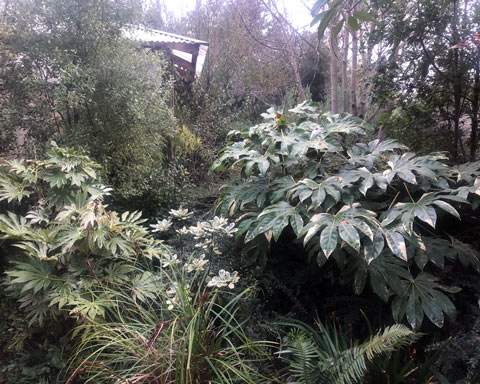
Sam: You highlighted something too when talking about the 1990 frost in Berkeley about that scale of permanence that you often talk about, for example what we plant as street trees that are in the public spaces versus the experimental Aloe tender-ifolia on the south side of your house and how you think about that.
Sean: Well I will always encourage experimenting. And when you start getting really old and start getting a little bit jaded you start seeing a lot of things that have happened before. So what do you do? Do you say, “Oh that will never work!” No, people have to learn and they have to play. There’s a place in Centralia, WA where they planted a bunch of Aloes on the south side of their house. And they were living clear since last summer, so fine, go for the mystery and lore, but we know at some point this winter it will get too cold and they will probably turn to mush and disappear. But where do you want to say it won’t work and where do you want to say, there’s a lot of potential here but there’s some things you might want to try. There’s this sense of exploration, and you don’t want to make somebody feel like there’s nothing new to try but you also don’t want to see them nipped in the butt by failure.
And so when I first moved back to Portland there was a nurseryman in Washington who did a sort of a spoof in his catalog. And there were these two guys that moved to Portland and put all their tropical houseplants outside over winter and then were just heartbroken when everything died. And I then did a spoof on his spoof in a newsletter at the time and I coined something called “Zonal Denial” and the message there was “don’t be stupid” essentially. All these plants come from places that have weather and you can research what weather and kind of climate they have there. So do that!
Sam: You can deny your zone but do so intelligently.
Sean: Yeah, so you can have any look or feel you want to your own garden, whether its tropical or what I call real zonal denial which is New England in the Northwest. And you can do that, just do it with things that look good here and like the climate.
Sam: And maybe know why you’re doing it and group things accordingly.
Sean: Exactly. And that’s not to say that many of us won’t be out at 3 a.m. in our bathrobes with frost cloth trying to protect our special thing that’s tender but we want to grow it. That’s cool too.
Sam: But you know that’s part of the deal.
Sean: Yeah, and it’s part of the fun and it’s part of the challenge, but it’s interesting doing it for yourself versus doing it for a client or in a public space. You’re not going to be at their house at 3 a.m. in your bathrobe. If you are I won’t get into that… But you need to kind of picture the situation, and you’ve done that with what you’ve planted here. So picture it’s the coldest night in 5 years. I’m having a dinner party. Your client is having a dinner party. Do you want them out covering up all their tender plants? No, they’re inside looking at the lighting on their trees and no matter what happens their plants are going to be fine.
So there’s the no-brainer stuff, like a loquat. No matter what it just ain’t gonna get hurt here. Despite all the lore, all the talk about some being tender. But no, there’s no tender ones I’ve found. So we are building these pieces of botanical furniture that we know are going to be fine no matter what happens. And that’s kind of the way to start with people when you’re pulling people gently into the plant world. We want them to have a good experience. And there’s the old lore out there that says you want your customer’s stuff to die so then they buy more. But we’re not about that.
Preston: Because if they think they can’t grow these cool things, then they won’t.
Sam: Or they’ll go plant something far safer and more pedestrian.
Sean: Yes, so breeding success.
Sam: Ok, so last thing. We have this grand vision. Sean Hogan is now Portland’s Mayor of Horticulture. What would be those things you’d have become the staples rather than red maples, ashes, etc.
Sean: Well I think any city has a palette that makes it what it is. For example if you look at the outside at Portland airpot right now, you could be in Cleveland or New Jersey, wherever. There’s no sense of place. It’s taking a mix of plants that are both native and do superbly well here and really pushing those. So Canyon Live Oak is native, Oregon White Oak is native, Ceanothus, Manzanitas, native. It’s a look. Not much of the world can do those plants and we can, so why not?
But we have other things. Things like Clerodendrum that do better in Portland than almost anywhere else in the world besides some obscure Asian habitat. But they are an interesting Portland thing, where people visit they say, “What are these things? They’re so beautiful!” So I don’t think we should be purists, but we should celebrate what we do really well.
Sam: Yeah, like you arrive at Tucson airport and it’s really obvious for people to grasp that they’re in a different climate, because it’s so drastic and they expect it. But here you can fudge a lot of different things because we have the winter water and do a bunch of different things and our climate is more forgiving. But there you arrive and you’re like “Yes! Here I am! I’ve arrived.”
Sean: I’m here! And our airport and city could be the same way but instead it’s sort of generic big nursery stuff. But can you imagine what it could be like, with all the unique characteristics our climate has?
And a lot of what we can grow, food stuff wise, things you’re doing, finding hardier citrus, guavas, better loquats…
Sam: Figs! Supremely adapted to our climate.
Sean: Incredibly adapted. Absolutely. So there’s some pretty fun stuff.
Sam: And far more fun than what’s been presented to us as standard.
And so finally, where can people go to see this emerging plant palette, specimens in action if you will. There’s Cistus Nursery of course which your employees always joke is a botanical garden with a nursery attached. But where else can people go to find these things, though it’s often just going to find single individuals around town.
Sean: Right, well there is that, and it’d be better if that were better recorded. But there are some projects we’ve done, like Argyle Winery is a good place to go where we’ve planted a bunch of things. But an easy one is Hoyt Arboretum. We’ve planted a lot of things around the visitors center and a little known secret that just a few hundred feet down the street from there on that hill you have incredible specimens of Canyon Live Oaks and Notholithocarpus.
Sam: And Hoyt has that incredible online database so you can search by species or genus or family and locate everything they have in there.
Sean: Exactly. So there’s that. North Willamette Research Station often has some interesting things, just did a large Arctostaphylos trial there. But by and large you still have to go looking for it.
Sam: Awesome, thanks Sean.
